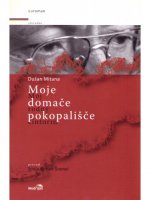
Dušan Mitana’s journey to the shelves of foreign bookstores took considerable time, though, I remember that in linguistic regions accessible to me, he was at least introduced in magazines relatively early on (for instance the publication of Polish translations of short stories from Dog Days – Psie dni, and Night News – Nočné správy in Literatura na Świece in the 1970s had met with a favorable response); later on book publications followed and after 2000, Mitana became a quite often translated Slovak prose writer.
Surely interesting is the contrast between the response of literary critics and readers – while after the publication of My Native Cemetery (K.K. Bagala – L.C.A. 2000) the critics at home reacted rather half-heartedly (i.e. the opinion of D. Kršáková: “… in the 1990s his writing took a quite dubious course… My Native Cemetery did not improve this damaged reputation…”. From Knihy a spoločnosť 3/2006), the book saw its second edition the following year. The fact that Croatian and Slovenian publishers chose it for translation only proves its success… Thanks to the author’s sense of irony about the absurdities of the system and the two-facedness of the rural environment during the building of socialism, presented through a seemingly naïve child-like view, the foreign reader, too, has a chance to enter the microcosm of family, generational distastes and alliances, and learn something about our mode of day-to-day living – adaptive and also defiant.
This novel, featuring many autobiographical features, describes the coming-of-age in the family of a gravedigger in his native village. These times, as the author says, “inescapably marked his future life and work”. With a humorous, at times sarcastic, style Mitana captures the environment of a village in western Slovakia in the late 1950s and introduces a whole gallery of bizarre and grotesque characters. The story of coming-of-age and maturing, however, harbors also greater and further-reaching observations which could provide material for a sociological analysis of the villagers’ interpersonal relationships sprung on a cross between the ruling (post-Stalinist yet still totalitarian) communist ideology and two churches – Protestant and Catholic – while their mutual denominational relationship is hindered by many ideological disagreements.
At the center of the story, there are three generations of one family. While the middle one, represented by the gravedigger and his wife, is frequently a source of ridicule due to their simplicity and naïïveté (he does not even attempt to grasp the narrow-mindedness of the social system, he is content with his cemetery job which he took after his father and refuses any display of progress or anything foreign), the older (father Eliáš) and younger (older brother Servác and younger brother Pankrác) are presented more “seriously” – they draw up an alliance thanks to traditions and a suspected transcendence in the cemetery’s deathly space, and find common grounds thanks to their grandfather’s graveyard stories told to one of the grandsons.
The fictional memoirs narrated in the first person are perked up by lively dialogues which complete the characters – the western dialect helps in dertermining the protagonists’ social status – the gravedigger and his wife almost always speak it, and grandpa and Fidibus speak it rather often, while the main character Duško (Pankrác) insists on speaking the proper language for which he is frequently laughed at. (Here I must praise the inventive translation of Špela Sevšek Šramel – she succeeded in transfering into the dialogues a vibrant colloquial as well as dialectal Slovenian in all its flexibility, swallowed vowels, she got round archaisms in citations from Maliarik’s opus Global Universal State, imaginatively played around with verses in chapter eight, and on top of that she rewarded the Slovenian readers with an afterword full of information not just about the author but also about the circumstances of this pseudo-memoir’s origins, as well as about the priest Ján Maliarik, and even provided an illuminating annotation about Mitana’s typical reckoning with critics that were unfair to him...)
Let’s hope that literary gourmands in Slovenia do not miss this kind of refreshment. The book was published in an elegant binding with a cover on which Mitana’s eyes are clearly looking far beyond his „native cemetery“ and the map of Slovakia splashing out of the bloody red of the beloved past.